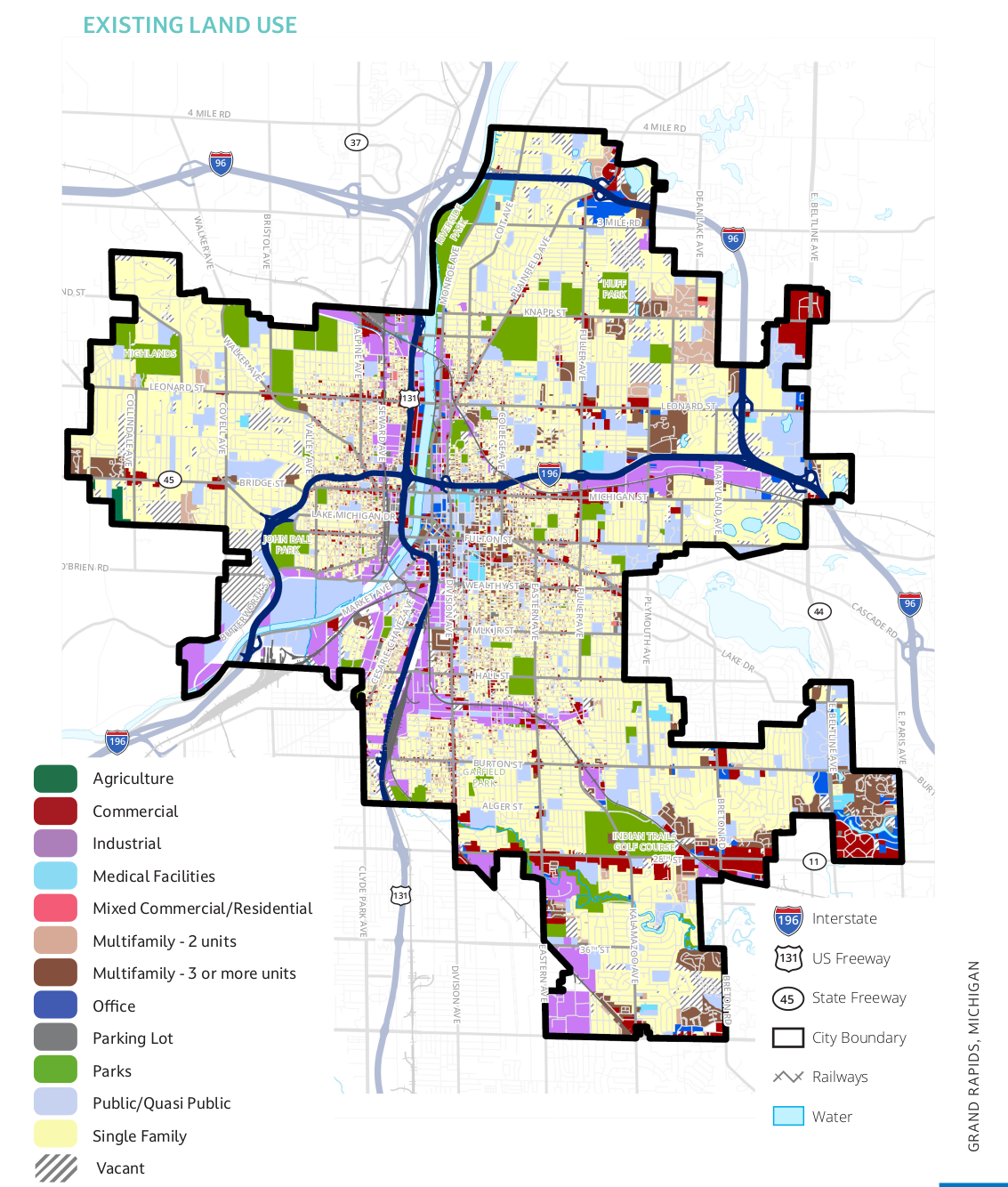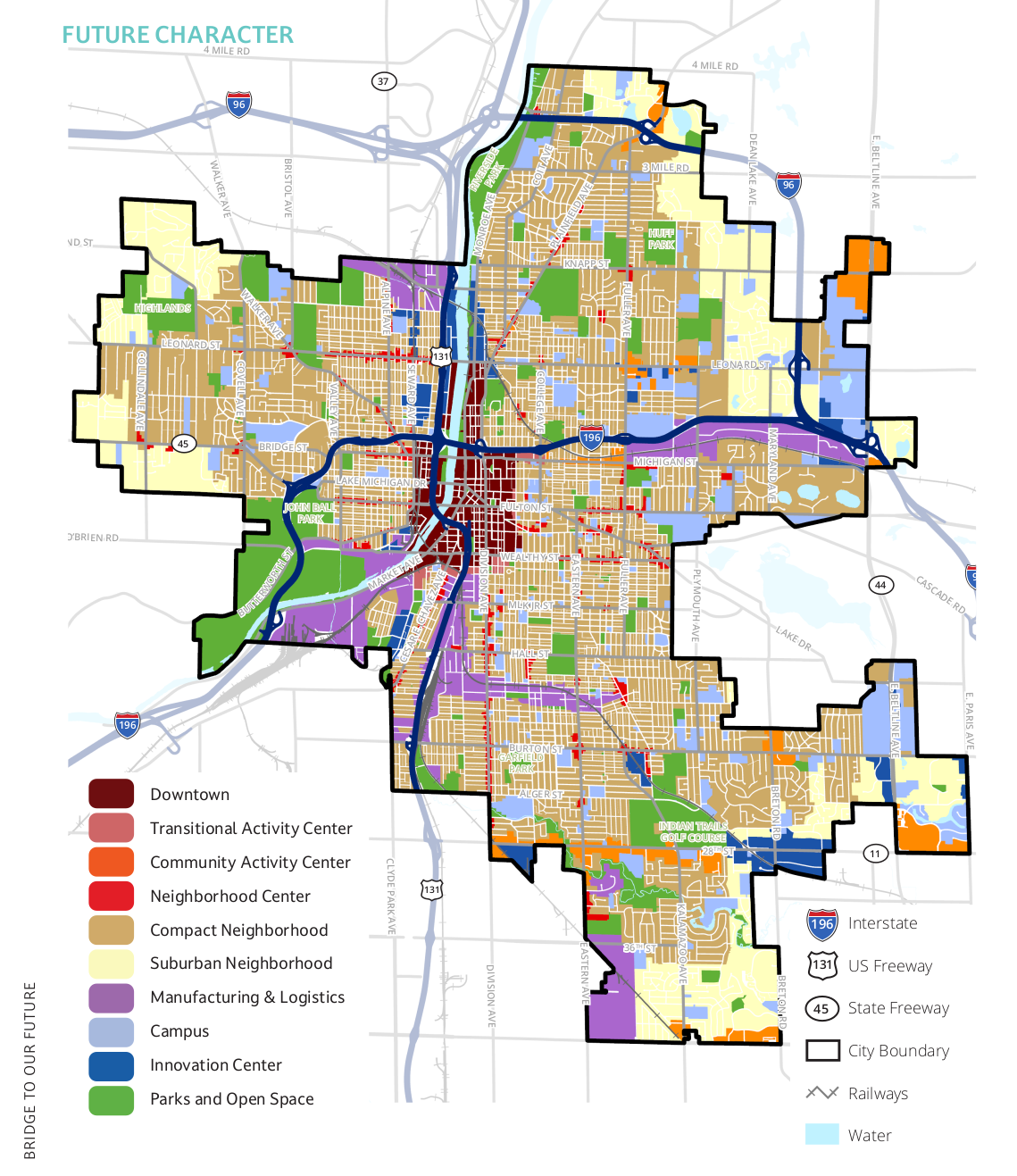CC/PC Special Meeting Regarding Master Plan Draft
On 2024-07-16 the City Commission and Planning Commission held a joint meeting to begin final review of the new Bridge To Our Future Master Plan. City Commissioners O'Connor (1st Ward) and Robbins (1st Ward) were absent. The format of the meeting is a presentation by the Planning Department and their consultants, followed by questions from City Commission and then the Planning Commission.
Document: BridgeToOurFuture.MasterPlan.Draft.202407 (PDF, 79MB)
The conversation was telling, and provides some insight on what direction the plan and resulting ordinance may, or may not, go. Some of the highlights are as follows:
Highlights & Thoughts
0:37:40: Regarding bullet point #2 on page 16, regarding the "unique character of Grand Rapids" it would be helpful if you [the Planning Dept] would identity what that means. -- City Commissioner Goei (3rd Ward)
A very good question. There is too much floral language in all of these plans; which consistently goes unquestioned. As a fourth generation Grand Rapidian I have no idea what this callout means or what the "unique character" of Grand Rapids is. From my perspective Grand Rapids has a nearly boiler-plate industrial mid-west American city history: created on a river for transportation reasons, experienced an industrial boom with the arrival of the railroads, bosses captured city government to suppress labor organization, economic and geographic segregation as a way to sustain a dominant political coalition, and then everyone finally found common cause in turning against the infrastructure which created the city in the first place. And here we are. Every major mid-west American city is on a river, every mid-west city ripped out their transportation systems, and every mid-west city attempted to down-zone itself into a suburb.
Beyond the mid-west I've wandered around Miami and Jacksonville (Florida) and been struck how neighborhoods there have near equivalents with neighborhoods in Grand Rapids.
I spend most of my time in the eastern west side and the western east site [Creston, Belknap, Highland Park] and I also fail to see any architectural vernacular in any of these neighborhoods; almost every neighborhood is a scatter plot of styles, sizes, and types.
In context of neighborhoods, land-use, and development patterns what are the unique characteristics of Grand Rapids? I would be very interesting in seeing that discussed at some substantive level of detail.
0:40:40: That they said reduce space for cars, such as parking lots, to support more compact walk-able development. It would be interesting to see what side of town that comment came from. Just throwing that out there. -- City Commissioner Knight (2nd Ward)
Hopefully the commissioners will remember that the feedback to create the master plan has a high correlation to demographics and is statistically significant. The feedback from angry people who show up at meetings is not, a well documented problem with public engagement as it is commonly practiced.
0:41:15: The one question I have related to that [opportunities for higher density] is really more just about specificity and whether the plan, the final plan, intends to be much more specific with some of the corridors where we see there is greater opportunity for higher density development. I see some of the language but it is not specific to 28th St, Alpine, Plainfield, downtown. ... Talking about this balance between making sure there are housing opportunities for everyone, that we do, that we still need low density housing developments where families can raise their families in a single family home if that is what they choose vs. a townhouse vs. a duplex. So having more of those mixed housing developments but also identifying where we can have the higher density developments, where that fits. -- Mayor Bliss
The lack of specificity in the plan is notable. Beyond that, a majority of the city is low-density residential, and there is nearly zero opportunity to build more. This fixation on preserving single-family detached housing is a consistent theme of the mayor.
On the other hand, there are some details the master plan does focus on, such as setbacks. Setbacks are called out seventeen (17) times. Mandating consistent setbacks is a quiet - via tedium - way to effectively freeze the "character" of a neighborhood. Lot sizes don't change, so if the setbacks - the unusable borders of a lot - also do not change, the size and type of building(s) are effectively pinned to the status-quo, without having that as a stated goal.
0:52:08: How are we also investing in pedestrian safety? -- Commissioner Perdue (3rd Ward)
This was the only call out to pedestrian safety during the meeting; appreciated.
Planning Commissioner Van Strien expressed his appreciation for the maps of existing land use vs. the future land use maps. The maps really do help clarify what and where the plan is talking about, especially given how vague much of it can seem. Those maps are these:
Existing Land Use (pg. 77) |
Future Character (pg. 78) |
As the conversation circled back around to mobility, and particularly the topic of bike lanes and cycling, the City Manager make a necessary point:
1:10:43: I will caution us to really be serious about what we say, and say what we mean in this plan. Because if it only sounds good we're going to have ... we are going to have a lot of conflict because staff is going to be leaning towards the direction of this plan in terms of our operations. -- City Manager Washington
Advocates and other citizens involved in regular engagement with the city will be familiar with this conflict. Ambitious plans which are not taken seriously, such as the Bicycle Action Plan (2019) or the Great Housing Strategies (2016), are good examples. Trust is a key component in community and good governance; dishonestly stating goals to appease some people and then back-tracking to avoid immediate conflict with others does not build trust and only defers the conflict.
One of my hopes is that, at least for awhile, this plan will have sufficient gravitas to finally move us forward on policy; from where we have been parked since the City Commission of ~2014.
The meeting ends on a high note; clearly demonstrating that there are people in this regime who have a clear and informed understanding of the challenges.
1:12:25: I would echo Commission Goei's question around the unique character of Grand Rapids. I think that word is a little bit dangerous and I think that a number of people in our community, many who show up at our meetings, would argue that many of the recommendations in this plan actually serve to weaken that character and so I think we need to understand really what that means. What the history of that word is. . . . How do we turn this into ordinances that allow these things to happen without having to come before these bodies and ask for permission to do them all the time. How do we make it easier to do the things that this plan will encourage and support. -- Planning Commissioner Jonker
1:15:25: From a "character" stand-point I struggled with some of the language in the presentation; the desire for more affordable housing being right above emphasis on Historical Preservation. Those two are exactly opposite each other. Historical Preservation does not contribute to affordable housing in any way, shape, or form. I have similar questions about engagement, and where the historical preservation comments came from, because I would guess not as inclusive as some of the graphs were. . . . . From a character standpoint I think it is similar to the parking and cars discussion, if we are about neighborhood character and the character of our city we need to be talking about people and not buildings. We need to be talking about the character we want for people and how we can support that and not what we want a building to look like. Because that is really what matters. Americans have this unfortunate desire to consider all things that are built permanent, and it is really one of the reasons why we've gotten ourselves in trouble from a housing standpoint is that we have a lot of single family neighborhoods and we consider all those buildings and their relationships to each other permanent and aren't allowing or making change very difficult. -- Planning Commissioner Swem
🔥🔥🔥
1:23:20: Especially on the issue of housing we keep saying it is a complex issue and requires complex solutions, and while that is true, people are very tired of hearing that, they want a plan, they want us to get to solutions, to actions and recommendations. - Commission Perdue (3rd Ward)
🔥🔥🔥 YES! 🔥🔥🔥
We have had these professionals and experts working on the "complex" issue for a decade, it is time to deliver.
A conversation on mobility fills the tail end of meeting, even including a recognition that H+T (Housing + Transportation) costs, combined are a component of affordability. Automobiles are acknowledged as an expensive mobility solution.
